How to File a Trademark in Argentina with the National Institute of Industrial Property – INPI
Introduction
Argentina, the land of tango, a rich culture, and stunning landscapes, is South America's second-largest economy. It is a nation rich in resources, with a literate population, thriving agriculture, and diverse industrial sector. It is a founding member of the Southern Common Market (Mercosur) a political and economic regional bloc that includes Brazil, Paraguay, and Uruguay. It is currently navigating the challenges of economic stability, yet it is also a G-20 player and is still recognized as an emerging market, albeit amid capital control shifts. A country of resilience, Argentina continues to make its mark on the global economic stage.
In this detailed step-by-step guide, we cover the essential aspects of the Argentina trademark registration process and offer valuable insights to help you navigate the intricacies of protecting your brand in this dynamic market. We provide a clear distinction between the requirements for locals (residents or legal entities based in Argentina) and foreigners. Whether you are a local entrepreneur looking to establish a strong foothold in the Argentinian market or a foreign company aiming to expand the scope of your brand, it is worth taking the time to understand INPI's trademark registration process in detail.
Trademark Registration in Argentina: An Overview
Trademark registration grants exclusive rights to prevent others from using your brand identity for specified goods or services. This protection, which can be extended to last indefinitely, empowers you to oppose similar trademark applications and take legal action against any infringement. Beyond protection, trademark registration can also add measurable value to your brand, making it more appealing to investors. It transforms your trademark into a high value asset, allowing for revenue generation through sales and licensing and offers an effective shield against counterfeit goods.
The trademark registration process in Argentina is overseen by the National Institute of Industrial Property (INPI), the government agency responsible for trademark registration and protection. Providing there are no public objections, it typically takes between 12 and 18 months, beginning with the initiation of your application until you receive official certification of your trademark. Trademark registration is valid for ten years and can be renewed indefinitely for additional ten-year periods providing the mark remains in use.
There are several key points to keep in mind when considering trademark registration in Argentina. It can be an intricate process, so seeking professional guidance is often a wise choice to ensure a smooth and successful registration.
Requirements
Both foreigners and locals can apply for a trademark In Argentina. Here are the general requirements:
For Locals:
-
Unique Tax Identification Key: CUIT - Single Tax Identification number) or CUIL (Unified Labor Identification number).
-
A Level 2 Fiscal Key or Clave Fiscal Nivel 2. This is a password provided by the AFIP (Argentina's tax authority), allowing citizens to perform online procedures using various devices with internet access. For businesses operating in Argentina, obtaining this key is essential for conducting tax-related tasks, such as submitting affidavits and issuing electronic invoices. The Fiscal Key comes with different security levels to safeguard user data. You can apply for the level 2 Fiscal Key via your bank's Home Banking section: locate "Servicios AFIP" and select "Crear Clave Fiscal" (the design and location of this option may vary on different banking websites).
-
National Identity Document (DNI).
For Foreigners:
If you're expanding your business into Argentina, there are certain formal requirements that need to be met when filing for a local trademark. This includes providing details such as information about the applicant and whether it's an individual or a legal entity.
In general, you will require the following:
-
Unique Tax Identification Key (CUIT/CUIL) if you have legal activities in Argentina.
-
A Fiscal key (Clave Fiscal), as above for Locals
-
Foreigner's ID Document or passport.
-
Legal Residence Documentation: If you have legal residence in Argentina, you should provide documentation that proves your status.
To have a business in Argentina, it is also essential to have a Clave Fiscal, since it is through this password that you can carry out your procedures as taxpayers, from submitting affidavits to issuing electronic invoices (see the section, Requirements for Locals for more details).
If you’re appointing a local representative, you must provide a signed copy of the power of attorney, along with a sworn statement by the representative affirming its authenticity and the validity of the mandate.
For legal entities, this involves providing documentation related to the legal entity's formation and the appointment of a legal representative.
Conducting a Trademark Validity Search
As for any trademark application, it is crucial to begin by checking whether your desired brand name is available and not already registered or similar to existing trademarks. To do this, you can access the online INPI trademark consultation system and conduct your own research. You can do a free or paid search.
On the INPI platform, there are 2 search types available depending on your access status. If you have registered using your Level 2 fiscal key (AFIP registration and Login), then you will be given a broader range of services that cover several search types such as bibliographic data and thematic searches.
Without AFIP registration:

With AFIP registration
For more in-depth searches, INPI's Technology Information Area offers several services. You can request reports made from national and international document databases of invention patents, utility models, industrial models and designs, and trademarks. However, these do carry additional fees to be paid within the platform.
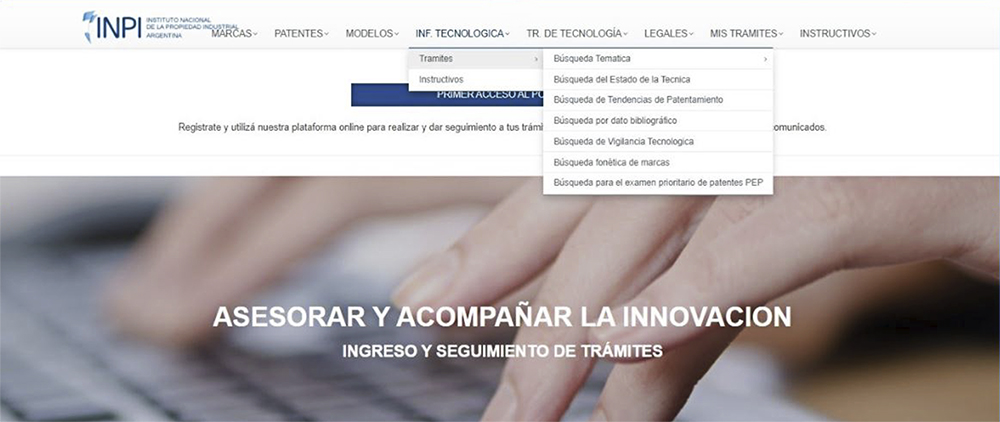
At Nominus.com, we also offer a trademark search engine where you can search according to Trademark names (similarities and equivalents) class and status (active or non-active).

As with other trademark processes, certain factors can lead to rejection when filing a trademark in Argentina. These include terms that describe products or services, widely used names or phrases, product shapes and colors, similarities to existing trademarks, potential for misleading consumers, moral and ethical considerations, and the use of official or international symbols. For instance, you can't trademark a widely recognized descriptive term like "refreshing" for a beverage or a shape that's commonly associated with a product, such as the iconic Coca-Cola bottle. Before submitting your trademark application, it's vital to evaluate whether your proposed mark falls under any of these categories, as doing so can save you time and effort, ensuring a smooth path to trademark protection.
Know Your Product/Service Class
Having confirmed availability, the next step is to accurately identify and classify your products or services based on their use for specific classes and according to local regulations. Trademarks in Argentina are registered following the international Nice Classification system. You can use the international classification page to help determine the appropriate class for your goods and/or services.
The Trademark Application process: Our 7-Step guide

STEP 1 Completing the Application Form
To begin the trademark registration process, you must access INPI's official platform for trademark applications here. We have broken down each section to be completed below.
Login
You will be asked to login using your CUIT or CUIL and then your Clave Fiscal Nivel 2 (Level 2 Fiscal Key - please see above for more details) to link the INPI service to your AFIP account for portal registration. If you have not yet created one, you will be able to do so from the AFIP platform (Argentina's Federal tax authority).
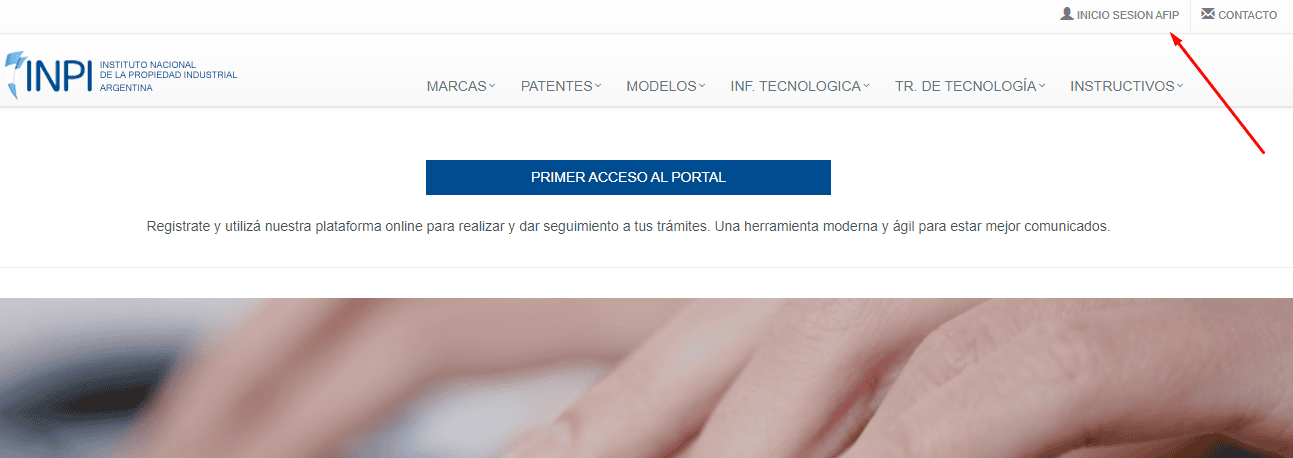

Once logged in, go to Marcas and Solicitud Nueva (new request).

You will now see the Trademark Application form which will show you the different sections you will need to fill out.

Datos de la Marca (Trademark Information)
Under Trademark information you will be asked to select the trademark type. As with most Trademark registration processes, Argentina offers a range of categories to choose from such as Denominative (text-based), Figurative (image-only) and Mixed. Each category has unique requirements, allowing for diverse trademark types to be registered in Argentina.


Protecciones (Protections Section)
Under the Protecciones section, you should select the appropriate international class (according to the international NICE system - international classification page) that corresponds to your products or services. If you intend to protect your trademark across multiple classes, you must submit a separate application for each class. Having chosen the right class, you'll see a dropdown list of products or services associated with that class. Make sure to select all relevant items to ensure comprehensive protection. Adding vague terms in the "Add Products/services not included" option (Agregar productos/servicios no incluidos en el listado) can lead to complications and extra fees, so it is wise to stick to the official list for a smoother registration process.

Prioridades (Priorities Section)
The following priorities section should only be completed if you hold a priority certificate issued by another Industrial Property Office member of the Paris Convention. Here you can make a priority request, backdating the filing to that of the application made abroad.
Titularidad (Ownership Section)
Here you should provide details about the trademark owner(s). You can choose between individuals and legal entities, and, if necessary, add multiple owners. In the latter case, make sure the combined ownership equals 100%. If you reside outside Argentina, you must establish a legal address within the country (see the Requirements for Foreigners section below).
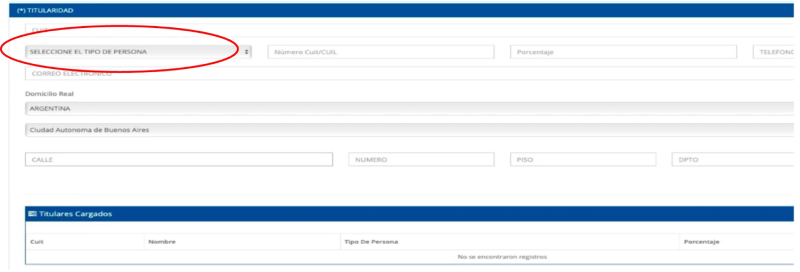
Representación y Autorización (Representation and Authorized Agent sections)
Next are the Representation and Agent sections (also optional) to be completed only if you need to appoint a representative for specific procedures. Start by selecting the type of representation you need. Then, decide whether you'll be represented as a private individual or by an agent, and the subsequent details will update accordingly. If you select a proxy agent, they should fill out their name, surname, ID (CUIT) number, and confirm whether they have a registered power of attorney with the INPI.


Observaciones y Documentación Respaldatoria (Observations and Supporting Documentation)
Lastly you can choose to include any extra information to add clarity to your brand application and attach any supplementary documentation that might be needed in the Observations and Supporting Documentation sections. This could include essential documents such as your company's constitution, a power of attorney, management ratification, or a certificate of priority. And if you don't have these documents readily available when filling out your application, don't worry, as you can always attach them later from the Escrito module in the Marcos dropdown menu.


Each step above is intended to ensure your trademark application is complete and accurate, giving your brand the best chance of a successful and smooth registration.
STEP 2 Signing and Payment
Once you've entered all the required data, you are given the option to save a draft or click on the "Finish" button to move to the payment stage. Click on Finalizar.

A small window popup will appear asking if you are sure you wish to proceed. Click on "Si".
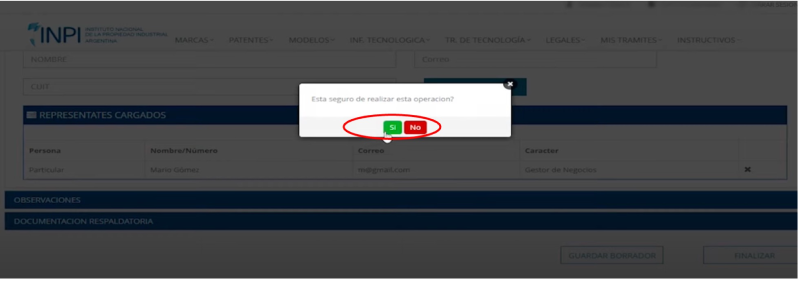
You will then be taken to a new Tramites (Procedures) page where you will see your application. Make sure the details are correct. Check any images or documents you have loaded by clicking on Formulario.
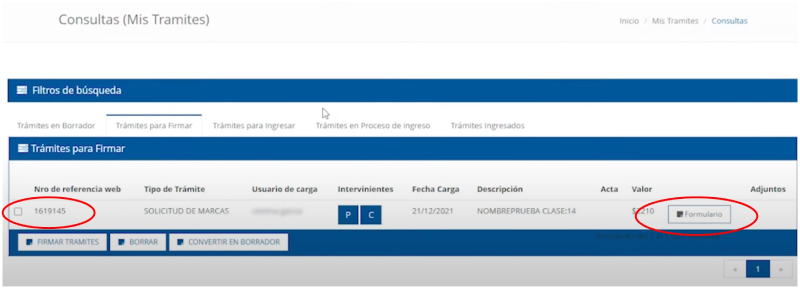
Electronic Signature
Once you are happy everything is correct, check the box to the left of the Request number and then click on Firmar Tramites (Sign Procedure).

Click on "Si" in the popup and a second window will appear confirming the procedures have been signed correctly.
Generate Payment Voucher
Click on the Tramites a ingresar (Procedures to Submit) section and you will see your pending application request.

Here you will be asked to generate the payment voucher. Check the box to the left of the Request number and then click on Generar Volante to create a payment voucher.

A popup will appear asking you to enter the CUIT number for whoever will make the payment.

Payment
Then select one of the 3 payment method options: Link, Interbanco or Banelco. Lastly, go to the section Tramites en Proceso de Ingreso to access the payment voucher you have just generated. Follow the instructions to finalize payment.

It's important to note that your application will only enter the INPI system once the specified fee has been paid. You should also complete payment the same day that you fill out the application to avoid elimination. Payment confirmation may take up to 15 days. Once confirmed, your application will move to the Trámites Ingresados (Entered Procedures) section, and you will be assigned a case number. Make sure to keep this number to hand as you'll need it afterwards to check the status of your application.
STEP 3 Formal Examination
Having received your application, the INPI will conduct a rigorous assessment to ensure it complies with all formalities. Should any prerequisites be found to be lacking, applicants are typically given a 30-day window to rectify any issues.
STEP 4 Publication in the Official Bulletin
Once your brand has successfully cleared the formal examination, INPI will publish the application in the official trademarks bulletin (boletín de marcas), signaling commencement of a 30-day window during which third parties may lodge opposition. Should any oppositions be raised, the process will be suspended temporarily until these issues have been resolved. If no oppositions materialize, the process will proceed to the next phase.
STEP 5 Substantive Examination
Once the publication and resolution period has expired, INPI will embark on a thorough examination aimed at assessing the brand's registration eligibility. This stage may involve administrative observations being issued, which may require professional intervention from a qualified lawyer or industrial property agent.
STEP 6 Final Decision
Having concluded its substantive examination, and providing your brand is deemed to possess the necessary distinctiveness to existing brands and meets all legal prerequisites, INPI will move to grant official registration.
STEP 7 Certification
Following the successful registration of your brand, an official brand certificate is granted, offering protection for a period of ten years from the date of registration. This protection can be renewed indefinitely in ten-year intervals.
Monitoring the Application
The INPI trademark application process in Argentina can vary in duration, but on average, it takes roughly 12 to 18 months from application to formal acknowledgment of your trademark registration. Please note, however, that this timeline can be influenced by several factors, such as the complexity of your application, the backlog of pending applications, and whether any objections or oppositions are raised.
Within your "Mis Tramites" (My Procedures) menu, you will see different tabs for completed procedures (those without a generated payment voucher), those in progress, and those that have already been submitted.
Your submission will remain in the Trámites en Proceso de Ingreso section until payment is credited, which may take up to 15 days, so you should not worry. The next day, you will receive the Case Number assigned to your application in your email inbox. From this point forward, for any inquiries or submissions, you should refer to your Case Number.
It's advisable to consult with a local representative (see below) or the INPI directly for more specific information on the current processing times and any potential setbacks.
Appointing a Local Representative
While it isn't mandatory for trademark applicants in Argentina to engage a specialized attorney, it is highly recommended (see the benefits section below). However, if the applicant does not reside in Argentina, they must enlist the services of a local agent when dealing with the INPI.
The Benefits of Hiring a Local Attorney
Local knowledge can be invaluable in Argentina, so it is recommended to have a local legal representation or trademark attorney to navigate the registration process effectively.
At Nominus, we specialize in offering expert guidance to international clients seeking to safeguard their intellectual property in South America. We're here to assist you every step of the way in protecting your brand identity.
So, if you're looking for a streamlined trademark registration experience in Argentina, Nominus.com presents a reliable and effective solution. Leveraging the expertise of local attorneys, Nominus takes charge of the entire process on your behalf from conducting comprehensive trademark searches to meticulously handling application submissions and closely monitoring their progression. To explore further, please visit our Argentina Trademark Registration webpage.
Conclusion
Undertaking the trademark registration process through INPI in Argentina is an essential step for businesses looking to establish themselves and thrive in this dynamic market. The Argentine process does involve several steps and can take up to 18 months, but once completed, it offers protection for 10 years, renewable indefinitely.
Trademark registration in Argentina not only protects your brand's identity but also enhances your financial potential by leveraging your trademark for various business purposes, including licensing and franchising.
Furthermore, it acts as a potent defense against counterfeiting, a challenge faced by many businesses in the region. With a registered trademark, you acquire the legal tools to take action against any unauthorized use of your mark, safeguarding your market presence and reputation and securing your brand's future growth in the country.